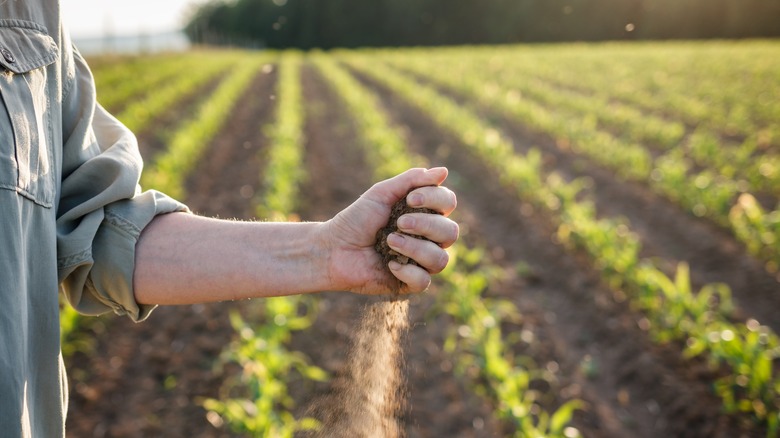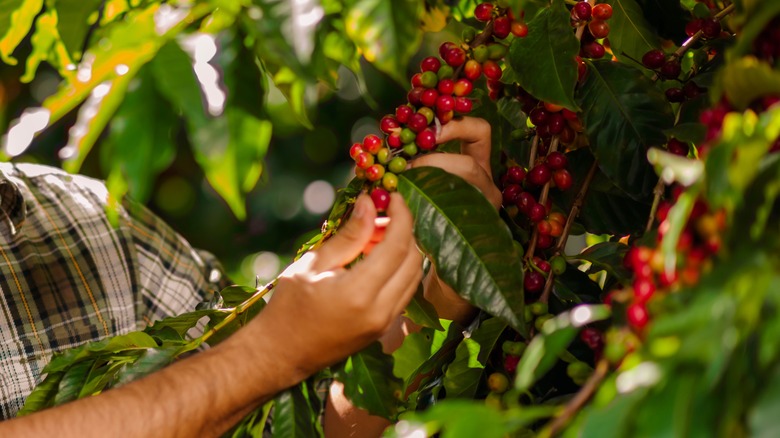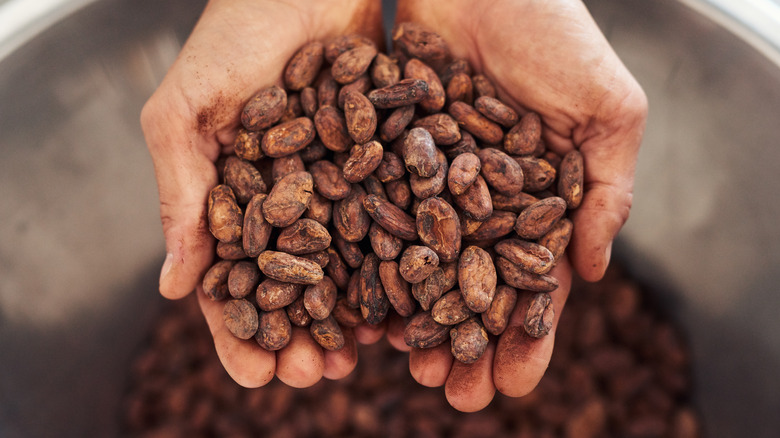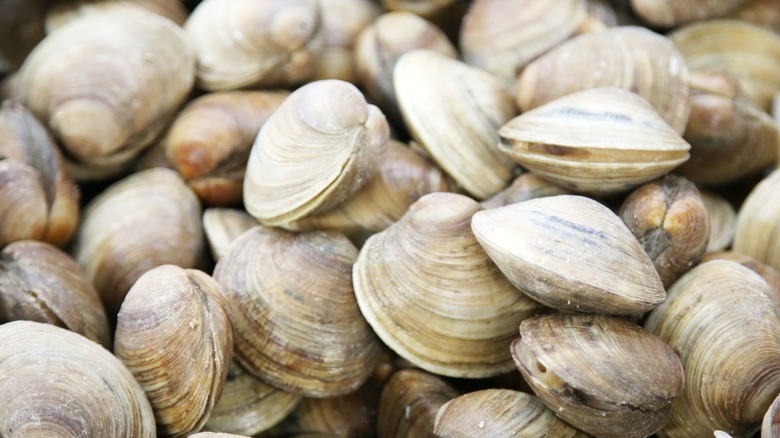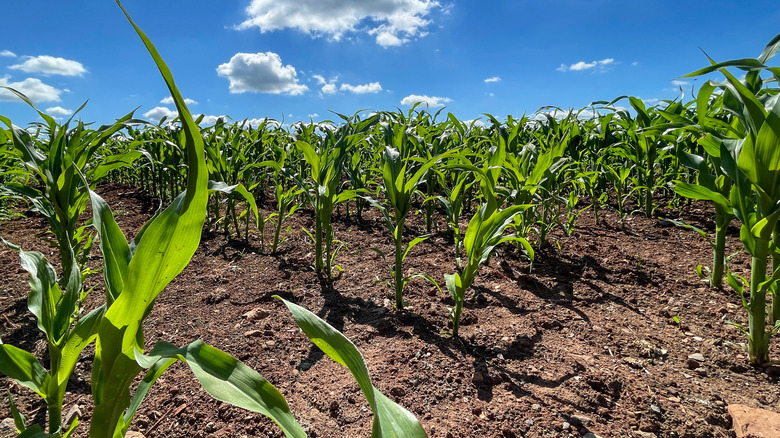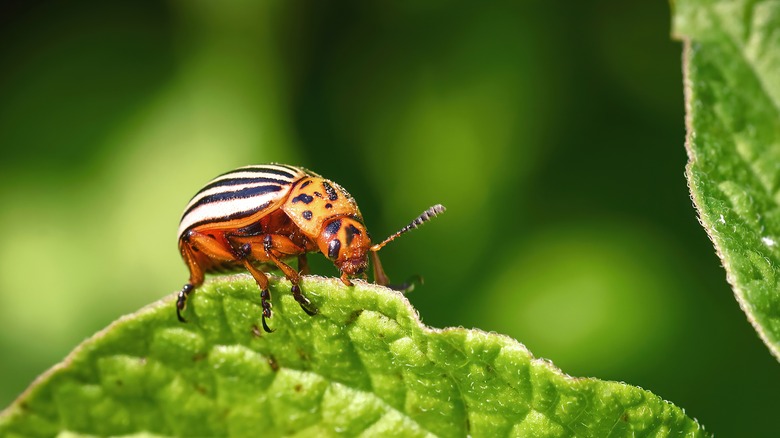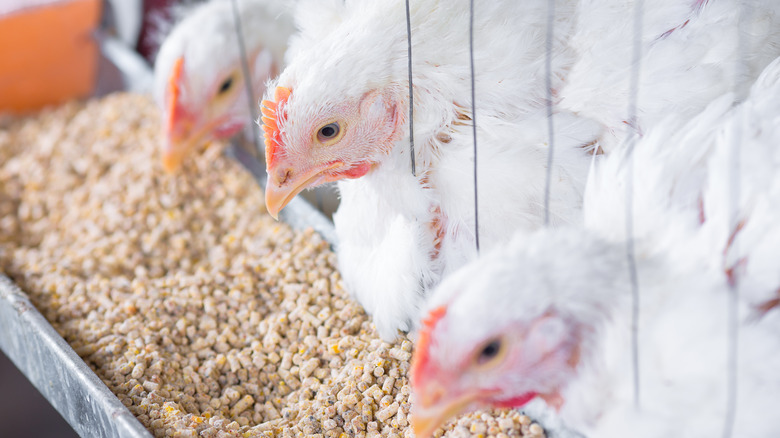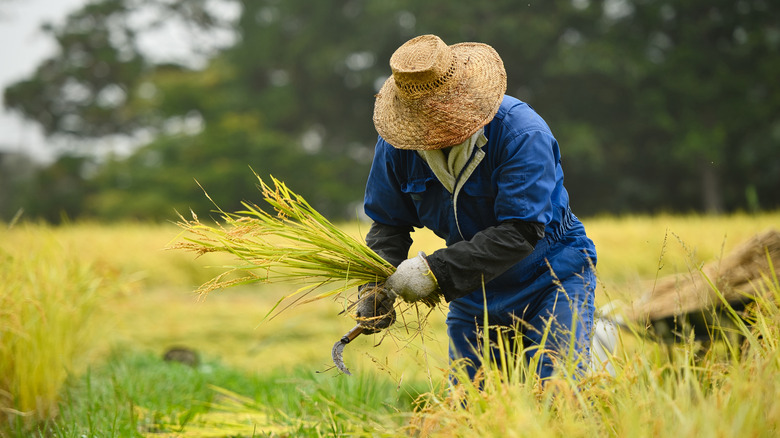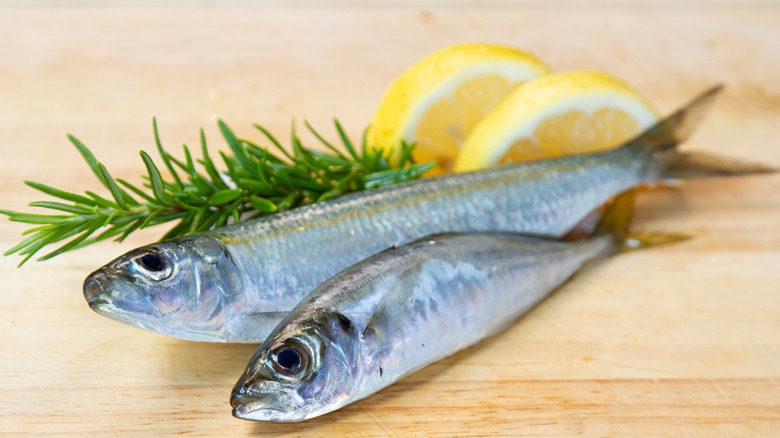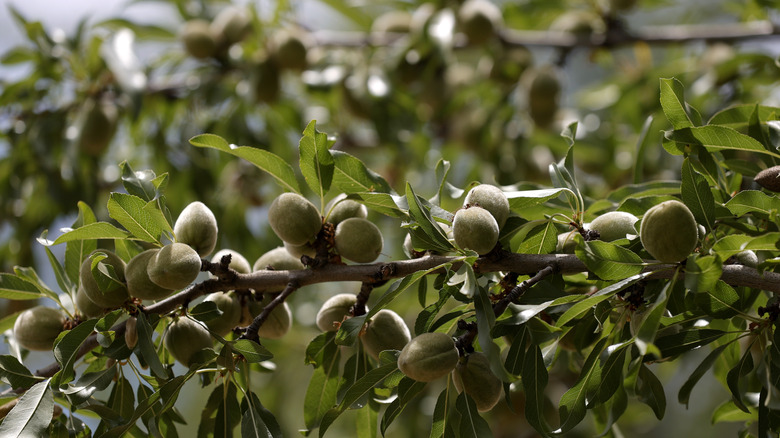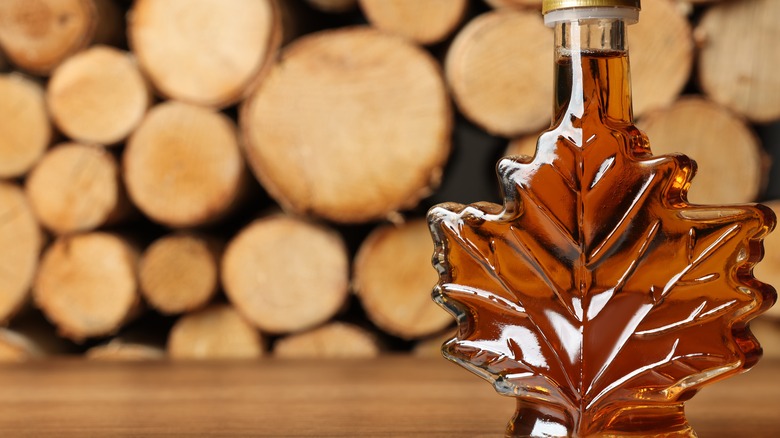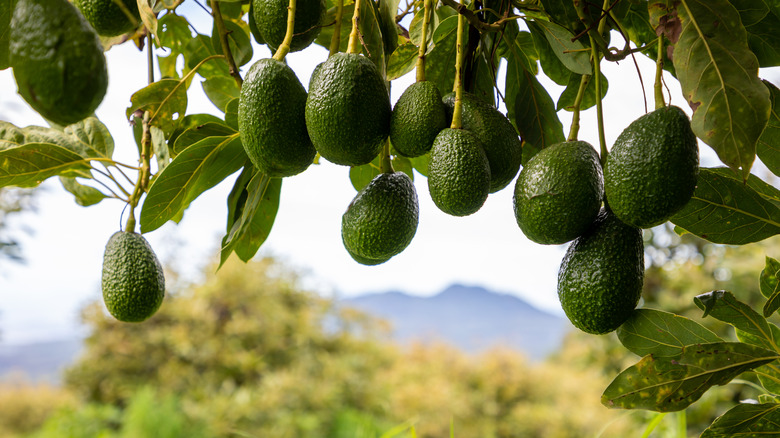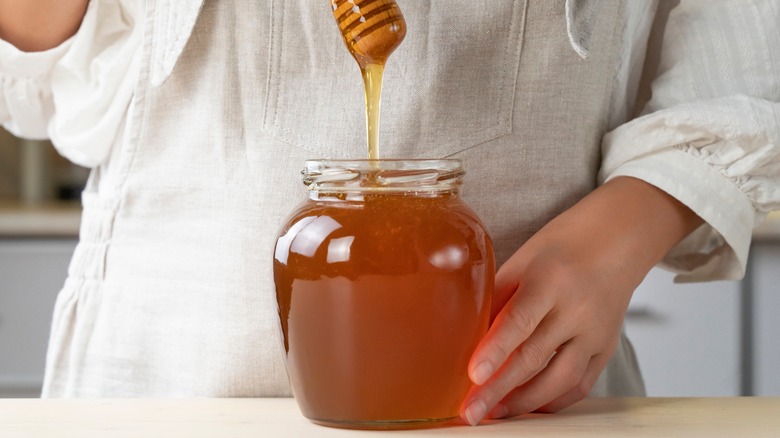How Climate Change Is Impacting These 13 Foods
Climate change may seem like a hot topic in modern political and advocacy discourse, but this scientific phenomenon has real consequences on the food we grow, catch, and harvest every day. According to Johns Hopkins University, the rising temperatures and increasingly unstable weather patterns have the potential to diminish food security globally, especially in regions with already low food security, such as Sub-Saharan Africa and South Asia. While science has developed the capacity to grow more drought and temperature-tolerant crops, there are limitations to the adaptability of the current species on Earth, many of which supply sustenance and support the taste palate of foodies.
Research by the United Nations has suggested that without strong adaptive plans, crop yields could decline by 30% globally by the year 2050. In the grand scheme of things, there is not much we as individuals can do to singlehandedly stop the planet's warming. But the more we can do to bring awareness to the impacts of climate change on the modern food system, the bigger imperative that we — regardless of political affiliation — will have to alter the trajectory of planetary warming. As it stands, some major food crops are already seeing the impacts of a changing atmosphere both domestically and abroad. And a whole host of other foods which, while yet to be severely impacted, are standing in harm's way.
Coffee
According to the International Development Bank, coffee producers are already seeing significant challenges in cultivation because of climate change. Latin America is home to half of the top 10 coffee-producing nations worldwide; this is because the central American climate provides the ideal humidity and temperature for coffee cultivation. But, rising temperatures are estimated to reduce the suitable coffee-growing land by 50% by 2050. Moreover, rising temperatures also support the growth of coffee rust fungus: a deadly pathogen that has already reached some parts of Guatemala, Honduras, and Costa Rica.
Recently, coffee has become more expensive with inflation, but over the last three years, the price of coffee has already risen by nearly 38.8%. The rising demand in the United Kingdom and the United States, as well as growing affluence and a taste for coffee in Asia, has caused further shifts in the coffee economy. In the next decade, we should anticipate fewer coffee bags on the shelves and increasingly higher prices for coffee in stores and cafes.
Wine
Most European wine production will be altered by climate change — especially in Spanish, French, and German regions. Already, climate change is drastically affecting the Champagne industry by bringing earlier harvests. According to Climate Central, wine grapes grown in these regions have a narrow temperature range of 18 F. Pinot noir grapes have an even more limited temperature range at around 3.6 F. Consumers should expect to see changing varieties on the shelves, as well as an increasing prevalence of mixed wines to replicate the same flavor as traditional varieties that can no longer be grown in a warming climate.
Domestically speaking, wildfires in California have altered suitable growing regions for Napa and Sonoma's wine regions. The smokiness from wildfires can alter the flavor of ripening grapes; grapes exposed to wildfire smoke are known to develop an undesirable ashy taste, according to Climate Central. In the United States, the average growing temperature has risen by 2.0 F since 1970. In California, temperatures within the growing season have already risen 2.9 F, thus making it almost unsuitable for wine grape production. As California vino is estimated to make up nearly 12% of the global wine market, the loss of the industry will be no small matter.
Chocolate
Chocolate is a guilty pleasure for many, but those traditions may soon change with rising temperatures in the cacao-producing regions of the world. The cacao plant is endemic to the warm, wet conditions of the rainforest. 70% of the global chocolate supply comes from West Africa, where a report from the International Center for Tropical Agriculture estimates that yield will decline as soon as 2030. The changing climate also indirectly impacts the cacao plant. Warm temperatures and altering precipitation can prevent other foliage from growing around the cacao plant; the lack of foliage causes a higher level of soil erosion and poorer soil structure.
While the current regions of cacao growing may change, there are opportunities for new regions to grow cacao. Per the Matador Network, Brazil and Nigeria may see more opportunities to surge in the cacao market. And within forty years, the ideal region for cacao may be in Northern Brazil and Guyana: two areas farther from the Equator that have yet to develop significant cacao infrastructure. In many places, chocolate is more than just foodstuff; but is a cultural staple as well. For example, the loss of traditions like chocolate-atole, an Oaxacan drink important to the practices of an entire region, isn't easily quantifiable — but will still be felt beyond bellies and tastebuds.
Shellfish
One of the major threats to shellfish is ocean acidification, per the Washington State Department of Health. The ocean absorbs carbon dioxide from the atmosphere and converts the chemical to carbonic acid. This acid dissolves the structure of calcium carbonate shells in clams and other shellfish. We can also expect to witness greater exposure to marine bio-toxins with the changing climate. Warmer temperatures can cause algae growth to spike; the algae can release bio-toxins into feeder organisms like shellfish. Research in the journal Toxins has indicated several risks of bio-toxin exposure via shellfish consumption, including paralytic shellfish toxins and ciguatera fish poisoning.
While there is some argument that mollusks are at significant risk, there are proponents on the fringe who suggest eating more mollusks. According to the BBC, shellfish have a significantly lower environmental footprint than land-animal agriculture because shellfish do not require specific feeding or care regimes. Mussels are also being used for physical climate infrastructure; the World Harbour Project, an initiative of the Sydney Institute of Marine Science, is trying to build retention walls out of mussels to improve water clarity and block the coast from storm surges.
Corn
Recent research published by Verisk, a data analytics company, indicates the yield for corn grain will decrease within the U.S. Corn Belt by 20 to 40% from 1991-2000 levels by 2046-2055. (In case you are unfamiliar, 1991 is a benchmark year as it marks what is considered the U.S. Normals, a 30-year average of climate data points received from weather stations across the country.) Furthermore, regarding corn, research from Emory University indicates that corn production in the U.S. Corn Belt, including states like Illinois and Iowa, will be impractical by 2100. Considering that corn is one of the crops with the highest acreage in the United States (estimated to be around 92 million acres per researchers at Penn State University), altering the growing conditions of corn will, without a doubt, dramatically change the agricultural landscape in the American Midwest.
Unlike many other crops, corn has important connections to animal agriculture, where it is a food source for species like cattle, pigs, and chickens and biofuel for ethanol production. According to Verisk, the U.S. corn belt produces 90% of the corn grain nationally and close to 30% of the global corn crop. The diminished corn supply, as the result of climate change, will alter the prices of wholesale corn as well as the products that depend on a steady supply of corn, such as high-fructose corn syrup, dextrose, and other food additives.
Potatoes
The humble tuber we know and love is not immune to environmental change. Compared to other crops, like corn, wine, and cacao, the potato is more resilient to environmental change. The potato does not require as much water as other food crops. Still, the International Potato Center states that water stress and the increased frequency of major weather events caused by climate change may impact the irrigation infrastructure supporting the potato crop. Additionally, warming temperatures will have ancillary effects on tuber plants.
What the crop is not yet resilient to, however, is the increased damage from pests and pathogens that thrive in warmer environments. Many of these dangers have yet to hit a stride but will increase as global temperatures become hotter. Alberto Salas, a potato researcher at the International Potato Center, notes that shifting the growing areas as a response to climate change, as well as introducing new types of cultivars with greater disease resistance, may help bolster potato production worldwide. So while we shouldn't expect to see potatoes disappearing from our dinner table any time soon, we may expect to see increased popularity in heritage potato varieties and resistant crossbreeds.
Livestock
Despite its role in producing 14.5% of greenhouse gas emissions globally, it's clear that a warming climate will indefinitely harm the livestock industry. The increasing air temperatures will likely lead to heat stress and increased disease occurrences, according to recent research published in the Open Veterinary Journal. Water availability is one of the most apparent climactic stresses on the livestock industry. The journal of Climate Risk Management asserts that around 8% of global freshwater is dedicated to livestock production. Rising temperatures may increase livestock water consumption by two to three times. By 2025, an estimated 64% of the world's population will be under water-stressed conditions, which further calls into question the ethics of diverting water towards animal agriculture over people.
Other indirect impacts of a warming climate on the livestock sector include the access and nutritional quality of forage and grain. Scientific research from Climate Risk Management has drawn linkages between the digestibility of certain forages in response to changing nutritional profiles. Potential impacts of this change in feeding may result in more crops being diverted towards animal feed production or increased land space devoted to growing feed. The increased cost to produce livestock will reflect on the global price and availability of meat and poultry.
Rice
Rice is one of the essential food crops of the world; according to Scientific American, the grain sustains more than half of the world's population. Rice farming is, by nature, a vulnerable crop because it is cultivated in wet fields called patties. Higher anticipated temperatures also speed up the process of evaporation, which can harm the flooding cycles of the patties. A 2018 study published in the Archives of Agronomy and Soil Science suggests the increase and severity of hot weather can cause yields to decrease by 40% within this century alone. Besides evaporation, increased temperatures can also cause the plants to stress and impair the plant's ability to pollinate. As Scientific American reports, patties in low-elevation regions are especially at risk for saltwater intrusion into rice patties, the bulk of which is threatened by storm surge from stronger monsoons, hurricanes, and alike.
Scientific American also reports that because rice is a cultural crop, climate change threatens more than just the plant alone. Many Asian countries have specific religious practices and traditions around growing rice threatened by rising water and cataclysmic environmental change. It's a reminder that climate change will affect more than just our stomachs.
Sardines
Sardines are delicious little fish at risk due to changes in ocean temperature and circulation. Per the National Oceanic and Atmospheric Association, the landings (catch size) of Pacific sardines are estimated to decline between 20% and 50% as fish move upwards on the American Pacific coast. The most pronounced warming projection may decrease the total catch of Pacific sardines by 20% overall by 2080.
Not only can we expect lower availability of sardines on the market, but the average size of sardines is decreasing. Researchers from the Ifremer Oceanographic Institute in France have studied sardines in the Mediterranean since 2008. The institute's studies have indicated that sardines are two-thirds as large as the average sardine 12 years ago. The phytoplankton that supplies the sardines with nutrients are not surviving in the ocean's warming circulatory system. The institute also credits the almost three-year-shorter life span of the average sardine to the lack of food found by the fish within the Mediterranean Sea.
Almonds
Almonds have never been known as the most environmentally friendly of crops; the almond industry is one of the biggest water consumers of all agricultural crops; growth is most common in the already drought-stricken regions of the United States. According to NPR, California produces 80% of the global supply of almonds. However, we are seeing that California almond harvests are decreasing due to record drought and heat. Between May and July 2020, production was estimated to have fallen nearly 400,000 pounds.
Like other crops, we can anticipate seeing almond production move north into regions previously unsuitable for growing almonds. Boise Public Radio notes the frost barrier that may have killed almond trees in colder regions of the country may dissipate with warmer temperatures. Agriculturalists are also starting to find ways to produce more almonds with less water on orchard lands, including replanting older trees with younger, less water-intensive almond trees.
So what does this mean for almonds on the shelf? It isn't clear at this point, but adapting almonds to colder climates may cause a supply chain shortage and sourcing disruptions in the foreseeable future.
Maple syrup
Can we no longer expect to see maple syrup atop our pancakes and waffles, thanks to climate change? According to the U.S. Geological Survey, maple syrup is produced by freeze and thawing cycles in the tree. Higher temperatures mean shorter tapping seasons, which in turn produces less maple syrup. The risk of higher temperatures and changing weather patterns may also result in the death of the tree, higher instances of disease, and lower quality sap production.
The southern range of maple production in the U.S. has already been deemed unsuitable for maple production, so the industry will be quickly forced to adapt to other options. One potential opportunity for the maple industry is to tap trees with a wider production range, including birches, different types of maples, and walnuts. This would diversify the products available and increase the syrup market's resilience if a pest or pathogen were to target the maple tree.
Avocados
Climate change will undoubtedly impact avocado farming. Research edited at the Potsdam Institute for Climate Impact Research in Germany indicated that the areas in Peru, Indonesia, and the Dominican Republic, which have once responsible for the bulk of avocado farming globally, will soon not be suitable for avocado production. Although this does not mean avocados will cease to exist in 2050, it does mean that scientists and agriculturalists will have to work together to find a sustainable solution to grow crops in higher altitudes and adapt breeding varieties to suit more inhospitable climates.
Some chefs are trying to cancel avocados, pulling dishes based on the fruit from their menus to reduce the environmental impact of the avocado industry. A single avocado requires close to 320 liters of water to grow. The fruit carries ethical considerations about the regions in which it is grown, leading to an often unseen dark side of avocado toast. Two avocados have the carbon footprint of an entire kilo of bananas and have cost thousands of acres of rainforest in the Central and South American regions in which it is grown, according to the Associated Press.
Honey
The USDA Agricultural Research Service notes that farmed honeybee populations are decreasing at a rate of 40% annually. Climate change is inextricably linked to the loss of managed honeybee hives. Shifts in the flowering plant cycles can cause nutritional stress on bee populations. In turn, this increases the susceptibility of the honeybee to colony collapse disorder and other pathogens.
The importance of the honeybee population extends past the production of honey itself. According to the USDA, the honeybee is responsible for the pollination of 80% of terrestrial flowering plants and 130 types of fruits and vegetables we eat daily. The ecological value of sustaining honeybee populations is insurmountable, even if it's beyond honey.
Although there are options to turn to alternative sweeteners like coconut sugar and date syrup to support the world's craving for sweetness, there has to be some effort to alter the trajectory of science to support pollinators besides farmed honeybees.
